Keith Knauss, Unionville-Chadds Ford School District school board member, and regular contributor to Community Matters, has written ‘TE Contract Costing’ that may help us all better understand the teacher-school board contract negotiations process and the reasons for certain decisions. I thank Keith for his research and for sharing the information with us. I have provided an overview below along with my comments. (If you have a problem reading the numbers in the tables, click on the graphic and a larger version will open in a new window.)
In his opening remarks, Knauss states …
“ … Understanding contracts has taken on new importance since Act 1 of 2006. Previous to Act 1, school boards could negotiate contracts and raise taxes to whatever level was necessary to balance the budget. Since Act 1, many districts have had to, with great reluctance, reduce staff and programs to keep budgets within the limits of the ‘cap’.”
Employee compensation is the major factor determining the size of a school district budget and, subsequently the real estate tax rate increase. If the District budget is to be balanced under the restrictions of Act 1, close attention must be paid to the terms of the contracts.
In the following table, Knauss presents the TE offer summary – the initial 1/9/12 offer by TEEA, the TE School Board 2/9/12 offer and TEEA 6/18/12 offer. The table indicates the average teacher compensation and taxpayer impact. According to Knauss, “The percentage increase in Average Teacher Compensation is more than the percentage increase of Local Tax Impact for 2 reasons … state subsidies and attrition.”
The following table reviews the salary and benefit packages of TE teachers. Krauss provides the approximate compensation (salary and benefits) for the average T/E teacher using the current teachers contract. The numbers are supplied by the District or are multiplications of the salary and the appropriate rate (PSERS and FICA).
Knauss presents the following Salary and Benefit table, offering that the “… Total Teacher Compensation is a straightforward multiplication of the Average Teacher Compensation and the number of Employees. Total Teacher Compensation is the money taken from the taxpayers (local and statewide) for the services provided by TE teachers.”
Here is an interesting graphic from Knauss, indicating the funding sources for teacher compensation. The major source of funding – local taxes and a secondary source of funding is from state and sales tax for half of PSERS and half of FICA.
Krauss looks at the effect of any contract settlement on the T/E taxpayers, and whether it can be financed within the Act 1 limits. He looks at two different costing methods – “One method looks at the total cost of the contract to all taxpayers, local and statewide; the other method looks at the cost of the contract to the local taxpayers to reflect the local tax impact of any other offer by ‘backing out’ the statement reimbursement for PSERS and FICA.”
The Local Tax Impact is calculated by “backing out” the state contributions to FICA and PSERS. Notice that the state contributes $3.0M in subsidies to lessen the Local Tax Impact.
————————————————————————————————-
When reviewing a teacher contract offer, Knauss supports the use of the following criteria:
- Is the offer economically sustainable under Act 1 limits?
- Are the compensation increases of the offer in line with the current economic climate?
- Is the compensation appropriate to attract and retain employees of quality?
Knauss answers a question that many have wondered … what happens if the teachers and the school board cannot reach a settlement? Due to substantial differences between TEEA and TE School Board, the union requested fact-finding by the PA Labor Relations Board. The independent fact finder will review both TEEA and TESD proposals and then make recommendations … however, remember the recommendations are non-binding.
The current teachers’ contract ends on Saturday, June 30. If an agreement is not reached, the teachers enter the “status quo” period, meaning that they continue to teach … to the expired contract. The teacher’s benefits and salary remain the same as in the expired contract. It is obvious that the School Board would not want an extended ‘status quo’ status for the teachers because it precludes any change to heath care benefits, compensation, etc. Knauss points out, that although the teacher compensation is frozen at its current level in ‘status quo’, legally the District must absorb any increases due to PSERS contributions or healthcare.
However, the situation is different from the teachers’ standpoint. During better economic times, the teachers would not want their contract settlement in ‘status quo’ state because working under the expired contract would mean that they would receive no additional compensation for years of service increase. But what choice do the teachers have?
According to TEEA website, the teacher’s last offer included a reduction in health care benefits and salary freeze for the first year. In their rejection of the union’s offer, the School Board instead asked the teachers to take a compensation reduction of $8,000 per teacher – which equates to as much as 13% for some teachers. There is little surprise that TEEA rejected that District’s offer, opting instead to go to the PA Labor Board. Why would the teachers want a new contract … status quo also keeps their current salary intact and preserves their current benefit package intact.
Knauss provides a multi-year analysis, assuming status quo and average compensation. He presents his analysis in several slides, giving us an idea of what certain scenarios would mean to the average taxpayer. To read Keith’s full report, click here.
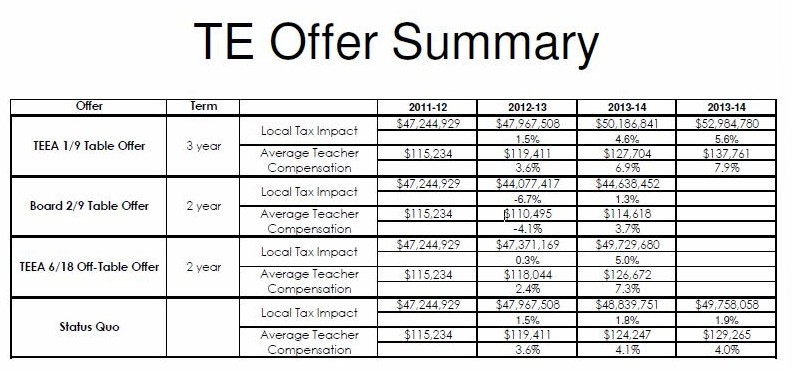
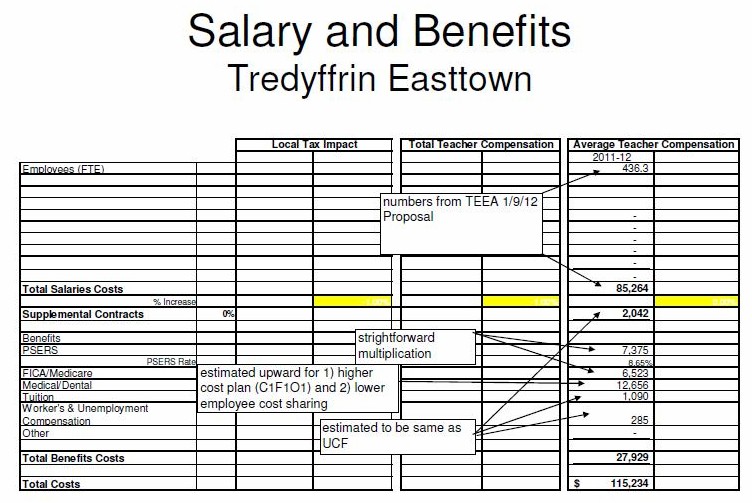
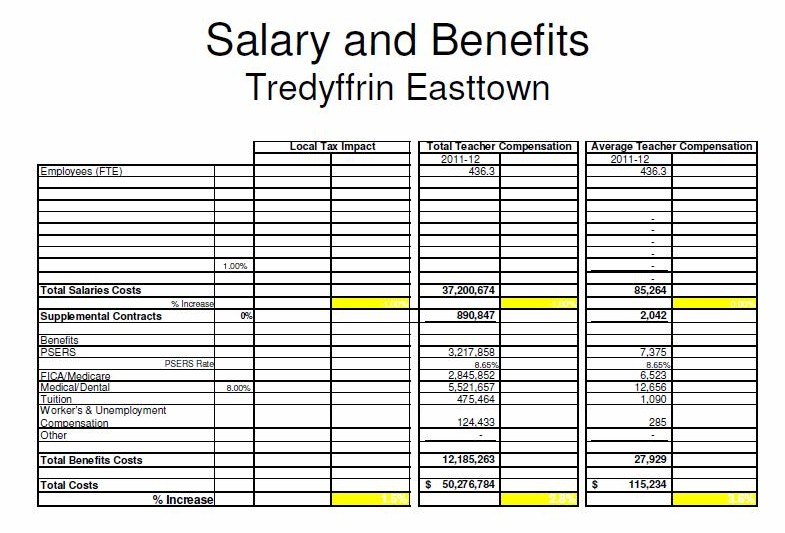
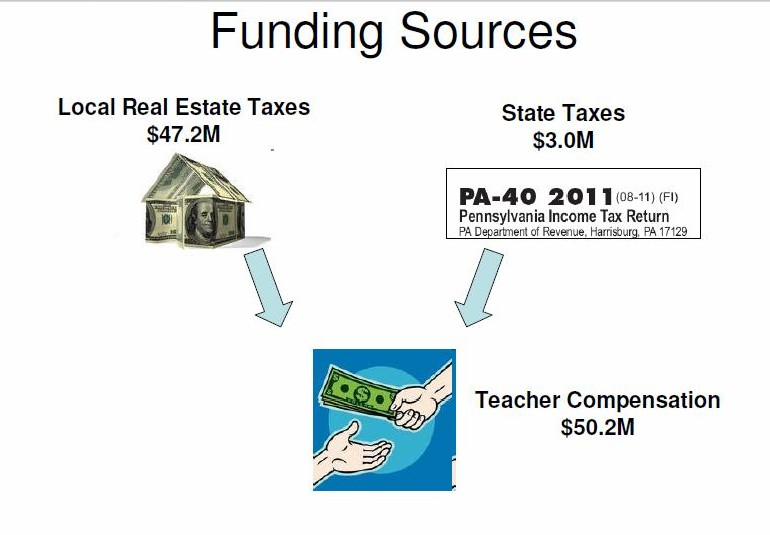
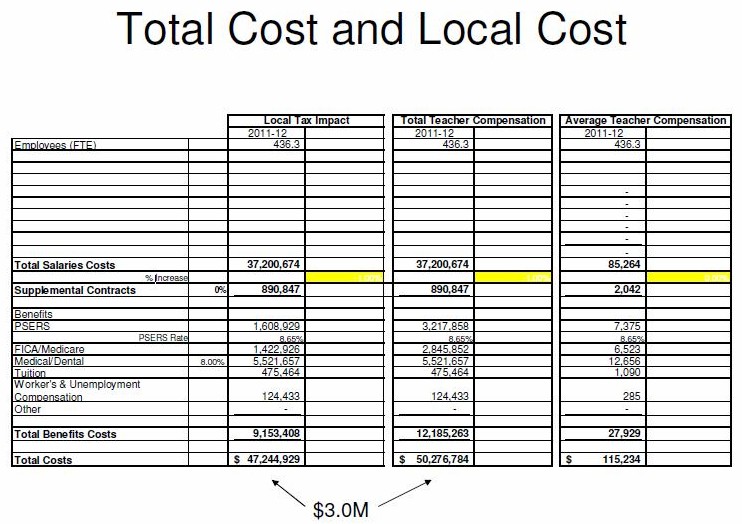
Keith provides a lot of information. Here are my take-aways:
1. It’s important to add up all the costs when judging the feasibility of a new contract. I would hope that the district is going even further than Keith does and knows the impact of the changes in sick days, sabbaticals, etc. that it is asking for.
2. When you do add up all the costs, the numbers are sobering. Annual total compensation of $115,000 is a pretty big number. I’m reminded of the term “public sector millionaire” that I saw on CM recently; teachers’ pensions are indeed equivalent to well over $1 million in the bank on retirement.
3. TE’s $115,000 compares favorably with UCF’s $103,000. As a local reference point, my salary-only comparison with Radnor last year also favored TE.
4. Keith’s analysis lowers to 1% the impact of attrition, about half the numbers that the district and union have been using for next year. I think that there were very few retirements over the course of the last contract (average tenure increased at close to a year per year), but in today’s world of course the calculus changes and this year’s number is unusually high. It’s interesting that at the limit (everyone on the top step) salary increases tend to the matrix increase. On the way to the limit, though, the big jumps at the top of the matrix raise the cost of any step movement.
5. The upcoming PSERS contribution increases build in a 3% or so compensation increase. But the state allows districts to raise taxes for that, equivalent to about 1% for the next few years (or more, if the rate of return assumptions get lowered again). So the real issue is, how to apportion the Act 1 index increase, basically equal to inflation. (But note that since part of the formula includes teacher compensation history, past is prologue). Is it in fact sustainable that (if all other costs increase just at the rate of inflation) there is no long run real increase in teacher compensation? I’m very concerned that future generations of teachers and students are being short-changed by the incumbents.
There’s a lot of discussion here about the potential to disadvantage TE if it holds the line on compensation. Well, it’s clear that the same problems with unfunded public sector liabilities exist locally, in our state and in the whole country. It’s wrenching to get that changed, but everyone is going through it. Some cities can only get there by declaring bankruptcy.
Which brings me to Tredyffrin Township’s recent 7-0 vote on its latest employee contract, with zero public analysis and discussion of its impact on the Township’s finances and tax rate. Do we need to send Keith’s paper over there? For example, there’s the introduction of a high deductible health plan, but who pays the deductible, and what’s the net impact? How much are the annual salary increases worth, when all the multipliers are applied?
Let’s boil negotiations down to the basics. The budget has to be balanced. Revenues must equal or exceed expenditures. RE Taxes comprise 70% of revenues and employee compensation comprises 70% of expenditures.
.
Therefore, as an approximation:
RE tax rate x assessment base = employee compensation rate x number of employees
.
We know that RE taxes increases have an upper limit set by Act 1 of about 3%. We know the assessment base is shrinking due to assessment appeals. If my analysis is correct, when the Union asks for compensation increases (Local Tax Impact) in the 4% per year range (1.5%, 4.8%, 5.6%) as in their 1/9 Table Offer then, by definition the Union is bargaining with their membership’s jobs. There is no other reasonable method to balance the budget other than furloughs and demotions. Why would the Union put an offer on the table that jeopardizes the jobs of their membership?
.
The Off Table Offer, likewise, would result in furloughs and demotions.
.
The status quo might be sustainable without employee reductions depending on assessment appeals, RE transfer taxes, interim taxes delinquent taxes and continued support from Harrisburg.
The 2/9 Board Table Offer is certainly sustainable and might allow for program expansion.
.
Note: The real numbers have to come from running each contract through a thorough 2 to 3 year analysis of all income and expenditures done by the business manager.
Thanks for this Keith — but as I have said here before, I would prefer to start with a major change in health care by changing the plan — and by doing so, starting off with money to work with. Your opening statement as offered by Pattye here is absolutely accurate — teachers have never done anything but sell their services at an increase each and every contract. WHen districts had money to buy, they simply managed the level of increase. I just don’t think enough people — including rank and file — understand this. So I would put the whole package on the table, showing them what we spent and what we could save.
One other piece to Pattye’s comments. Working under status quo doesn’t hurt the people on the final step one bit. In this expiring contract, 40% of the staff is on the final step, step 16. The negotiators are on steps 8-16. Some of them will feel pain at not getting to the next step. However, in fairness to their approach, the Pres of the union took the biggest hit of the negotiators in the 1/2 year deferral of step movement this past year. The district has to examine the composition of the benefits of the staff to cost out what status quo will cost them in family premium continuation.
Again I whine….change the benefit plan. Don’t negotiate a new plan. Change the plan and negotiate a defined contribution. Make it public. If the TEEA wants this to be a win-win, they would be doing this.
Can’t help but think that all this work Keith is doing is a little self-serving. UCF will be renogiating their contract at the end of this year and I am sure they will be looking to the TE contract very closely!
Had Enough,
.
You betcha! I have been and will be looking at TE, West Chester, Kennett, Souderton, Downingtown, Great Valley, Neshaminy, etc.
.
I’m hoping union leaders have been doing the same. Well educated negotiators on both sides of the table with up-to-date information make for productive discussions.
Keith,
I am going to do something that I can’t recall any regular contributors on this blog doing, admit I was wrong. I read through your report and found it very interesting. I am asuming that you trust the numbers you got from the district because they seem to change. I am just curious why it took a board member from UCF to lay out the numbers in a clear and concise manner and why the members of our own board couldn’t do the same. When you were negotiating with your teacher’s association did you have similar numbers to share with them and if so, what was their reaction?
Township Reader,
Unless members of the board are no longer required to live in their communities or pay taxes I believe Keith would be a taxpayer in UCF. That would make it his money in the case of UCF. The other thing I think you are wrong about is that the community in TE is not sophisticated enough to understand this. There are many intelligent members of the community who have sought answers from the board but never received answers/info as clear as Keith made it in his presentation. Step up and get on the bandwagon and admit you were wrong about something for once.
Hi Had,
.
You ask some interesting questions.
“I am asuming that you trust the numbers you got from the district because they seem to change Yes. Many of the numbers are projections subject to change as new information becomes available. For instance, we projected health care costs to increase by 8% last year, but it only went up by about 3%. Of course, thjs year it may go up by 15%.
.
“I am just curious why it took a board member from UCF to lay out the numbers in a clear and concise manner and why the members of our own board couldn’t do the same” For the same reason that no one did it before me – it’s a lot of work. One needs the appropriate understanding of finances (I have a management background, a ChFC and work toward a CFA) , a familiarity with Excel, a good business manager to work with, and the time (I’m retired) and interest to do it. This has been a slow, informal, give-and-take between the business manager and myself.
.
It is distressing that the PSBA does not help with contract costing. Wouldn’t it be nice if there were a common costing model with tabulated results for all 500 districts? PSEA does. I have seen the PSEA’s costing model and a tabulation of all contracts.
.
“When you were negotiating with your teacher’s association did you have similar numbers to share with them and if so, what was their reaction?” I’m only going to speak in generalities to answer this question. We share the numbers and make a point of inviting the union to sit with the business manager, at any time, if there are questions. I’ve found some union negotiators very capable of understanding the numbers; other less so. I can say the same about school directors.
.
And one more comment – I’m spending other people’s money not my own. When I vote to raise RE taxes in UCF by 1%, I’m collecting $550,000 from the community. My share is $50. One of my favorite passages is from the Nobel economist Milton Friedman and it applies to many school directors. [smile]
.
“There are four ways in which you can spend money. You can spend your own money on yourself. When you do that, why then you really watch out what you’re doing, and you try to get the most for your money. Then you can spend your own money on somebody else. For example, I buy a birthday present for someone. Well, then I’m not so careful about the content of the present, but I’m very careful about the cost. Then, I can spend somebody else’s money on myself. And if I spend somebody else’s money on myself, then I’m sure going to have a good lunch! Finally, I can spend somebody else’s money on somebody else. And if I spend somebody else’s money on somebody else, I’m not concerned about how much it is, and I’m not concerned about what I get. And that’s government.”
Had
Wow…even opinions get scrutinized. Email lacks tone, and readers seem to draw their own conclusions and then project that understanding onto the rest of us.
Keith explained what I obviously meant about it to being his money. Your comment (which you now admit was misguided) insinuated that Keith’s motives for the analysis were self-serving.
As to the lack of sophistication, I meant that the members of our school board not the community are not sophisticated enough to understand this analysis. During the last election for school board, one of the unsuccessful candidates pointed without refutation that the “numbers” person on the board was leaving. Had you followed the board over the past 8 years, you would have observed that the numbers were largely examined and explained by Kevin Mahoney. My own observations over more than a decade inform my opinion that the sitting board generally are word people or law people or very involved parents. All important contributions…but not very intuitive about the numbers. SO I don’t think you can or should expect this level of sophistication from any of them, and the business manager may provide these kinds of studies, but they (the board) will hold them back from the public and limit their questions and answers to executive sessions. Even Keith minimizes his response when asked about his own district. He can and does do analysis here because he is not disclosing any confidential information, though I know some of his data came from RTK requests made of our district by residents of TE.
So…what do you want me to say I was wrong about? That the board isn’t sophisticated, or that they are too arrogant to ask questions publicly about the super secret negotiations?
HAD.. my question to you is.. “so what”?
Self-serving to analyze numbers? How about “helpful?” This isn’t Keith’s money whether it is TE or UCF, but it is his time.
I don’t think our district is sophisticated enough to even understand this, and I believe they are too arrogant to ask questions to learn more. But as a taxpayer and someone who pays attention to the numbers detail, I appreciate the effort. Pearls before swine sadly.
Keith makes an important point about the limitations of our models and the need for the district to do the analysis based on the actual numbers.
I think it might be interesting to ask ourselves: what would be our strategy as union leaders? We’re caught between the Act 1 inflation index, the consequences of the matrix and its steps, the high and increasing benefits percentage, and the program cuts already implemented. An impossible position. How to make the best of it?
1) Move to a lower cost health plan (ie one that incents individual responsibility), and accept that members will pay a larger percentage of that (lower) cost.
2) Eliminate anything that costs the district money that might have less value to members. Personal days? Teaching six periods?
3) Accept that there’s no room for the top end of the pay scale to increase, and that there need to be more steps to slice up the five percent or more increases at the top end.
4) Take savings from the above and apply to developing programs that reward quality, especially in new teachers. Things like perhaps a performance based bonus system that doesn’t get rolled in to the salary base? Perhaps a transition away from the matrix altogether?
Now of course the process requires that we stake out an extreme position and hope to tend to the middle. Perhaps the “off-the-table” proposals are a way for a more substantive dialog?
And point 5) Make sure that members are in a position to capture the upside from any increases in transfer taxes or assessments (if the townships and their residents don’t completely stifle economic growth ……). Maybe that would argue for longer contracts, with a conditional component?
Very doable Ray, as it was done before with a 6 year contract with the final 3 years basing compensation on retirements, COLA and health care costs. But there was a whole lot of trust between both sides, no PSEA presence in negotiations, and very senior TEEA negotiators working with board members who had similar financial skills to what Keith has demonstrated. Sensitivty analysis to construct future deals is probably too risky on the downside (since there is no incentive to risk it) for both parties.
Ray, TR,
.
I’m in favor of one-year contracts negotiated during the normal January to June budget process; not multi-year contracts. It seems self-defeating to take away one of the 3 “levers” available to balance the budget. The 3 “levers” are the RE tax rate, the number of employees and the compensation of the employees (the contract). Why give away the “lever” that has the least effect on the students and the community – the contract? The union, of course, loves multi-year contracts. How many times have we seen a contract settlement with an austere first year followed by overly generous subsequent years? (school directors are always tough in the short term, but overly optimistic that things will get better)
.
Advantages of one year contracts:
1) There is more certainty about State support, the Index, assessment appeals, the RE market and the general economy.
2) The trade-off between compensation increases, taxes and employment levels is visible. For instance, “We could give the teachers the requested 4% compensation increase, but even if we increased RE taxes to the maximum allowed we’d still have to furlough 7 teachers.”
.
Disadvantage of one year contracts:
1) Time and effort has to be expended each year. However, the reason negotiations are so time consuming is specifically because they occur infrequently. It’s probable that the negotiators for one or both sides have never been at the table before, are unfamiliar with the process and have not built trust. If contracts were negotiated each year, the players would be familiar with the process and contracting could become as routine as budgeting.
Very good points about the advantages of one year contracts to a district. We’d have to do it without hiring Sultanik every year.
In my posts, I was trying to put on a TEEA hat, thinking about how to sell a transition to the new normal. TE does still have a significant fund balance, and I think a good use would be to fund a shift to a – much – lower benefit cost (eg TR’s defined contribution plan), performance-oriented, new-teacher-friendly environment. It almost goes without saying that back-loaded baseless increases can not fly.
I have to think that a long term employee development and compensation program – within known constraints – would be better than yearly grinding about how to allocate the index increase.
KK and Ray
I’ll have to think about a one year contract, as right now I see too much downside to constant labor uncertainty. The best thing about settling a contract is knowing that you won’t be trying to change the rules for x number of years. Every time you negotiate a contract, someone tries to get something. That’s why the 6 year deal done a bunch of years back was a relief to all sides — and had parameters that dictated the cost of the final 3 years. And that was before smart phones and tablets!
But here’s the problem — the PSEA has their way of doing it, and the power is completely on their side. As I have said before, regardless of the economy going forward, we have to change the mindset that new contracts are bought. Boards have always bargained how much to pay to get a new contract. Sometimes working conditions were tweaked, but they had a cost too. That’s why negotiating benefits and not a defined contribution is so tiresome — because they design a plan and then the district has to shop it. And if they determine how much the teachers will contribute towards it, it doesn’t mean anything in the budget process, because you are still dealing with changing costs each year. A defined contribution could be negotiated with language that would trigger a change in the contribution if X occurred….an easy way (without any ramifications to PSERS or SS contributions) to improve compensation in a good economy that had no other impact.
Blah, blah, blah. The choir has our hymnals, but no one knows the tune.
Thank you Keith for this analysis. I know the hours you’ve put in and you’ve delivered clear concise (ok, maybe not concise?) information. You clearly understand what to ask for and what is important.
I don’t know for sure, but my guess is that local TE Board members may be restricted as to what they can publicly say. They may just be smart to publicly say nothing in the midst of contract negotiations, because that can be used against them.
I find it somewhat frightening how many of TE teachers are on the top steps – my personal experience is that many of the new teachers coming in are pulling more than their fair share of teaching and the older teachers tend to do it the same way, the same lesson plans, the same old ditto’d (ok, photocopied) handouts and tests. I see so much energy, creativity, and enthusiasm among new teachers, it makes me sad that they aren’t compensated as “fairly”. Clearly, the way to the top is getting the school district to pay for more classes and you move to the top of the salary matrix.
Excellent analysis by Keith. Very clear and understandable. I think experience bears out his observation that not everyone has the skillset necessary to engage in this analysis . .. its complicated. And this unfortunately includes many of the participants in the negotiation process with their varying degrees of interest or ability to sort this out. Kudos to Keith for making it easier to approach.
Also retired, but I do have a CFA.
MA
Keith – thank you for taking the time to do this. I think when people see the “entire picture” of what compensation, benefits, taxes, etc. cost they can better understand the calls for change many in the public are making.
Keith – thank you for this information! The best summary yet – by a mile.
I hate to say it and others hate to read it but it all comes down to 1 thing that doesn’t lie in the end:
MATH
All this TE is going to lose talented teachers is utter nonsense. Everyone is dealing with the same issue. Sure TE teachers – I am sure there are plenty of openings in the Philly school district.
I would favor a flexible longer term contract that can be adjusted as circumstances warrant. However, that would make plugging in numbers with certainty an impossible task and I highly doubt the union would ever agree to that.
It is clear now that the economy is not improving to the extent the union hoped for when they wanted the contract based on an optimistic view of the economy in the future.
The country, at every level, is insolvent. It is not just the TE teacher’s who are affected but everyone.
Thank-you Keith. Reader, I enjoy looking forward to reading your reasoned, well thought out posts.
Private sector jobs pay for public sector jobs. No private sector employer can give guaranteed pensions and free health care because it is unafforable. Public sector pay and benefits have been increasing at a higher rate than private sector pay and benefits for quite some time. Private sector employees see that they get less and on top of that they are paying taxes to sustain this inequity. Not only does it not make sense, it is unaffordable and unsustainable
I’m pleased to see that readers have appreciated TE Contract Costing. If you are a glutton for punishment, I have a more detailed presentation (42 slides) which evaluates several typical contract proposals and two popular financial gimmicks. (ERIP, use of the reserve fund).
.
See Teacher Contract Evaluation
http://www.efficienteducation.org/
I received the Annual Financial Report (PDE-2057) for 2010-11 from the business manager Mr. McDonnell via a right to know request. The Report has the details, 85 pages long, of how the district’s money was actually spent. The estimates of teacher compensation detailed above are reasonable. I’ll note that the unemployment compensation number and the tuition number should be a bit higher.
.
Citizens normally spend most of their effort looking at the Budget (PDE-2028), but the Budget is only a plan, passed in June, that may or may not be followed over the next 14 months. The AFR compares the Budget (the plan) to the actuals. There are details on health care expenditures, revenue sources, fund balance, bonds, transportation, etc.
.
The AFR for 2011-12 will be out in October.
.
If anyone wants a copy, 5.1MB, send an email to efficienteducation.org
wrong email – it’s efficienteducation@verizon.net